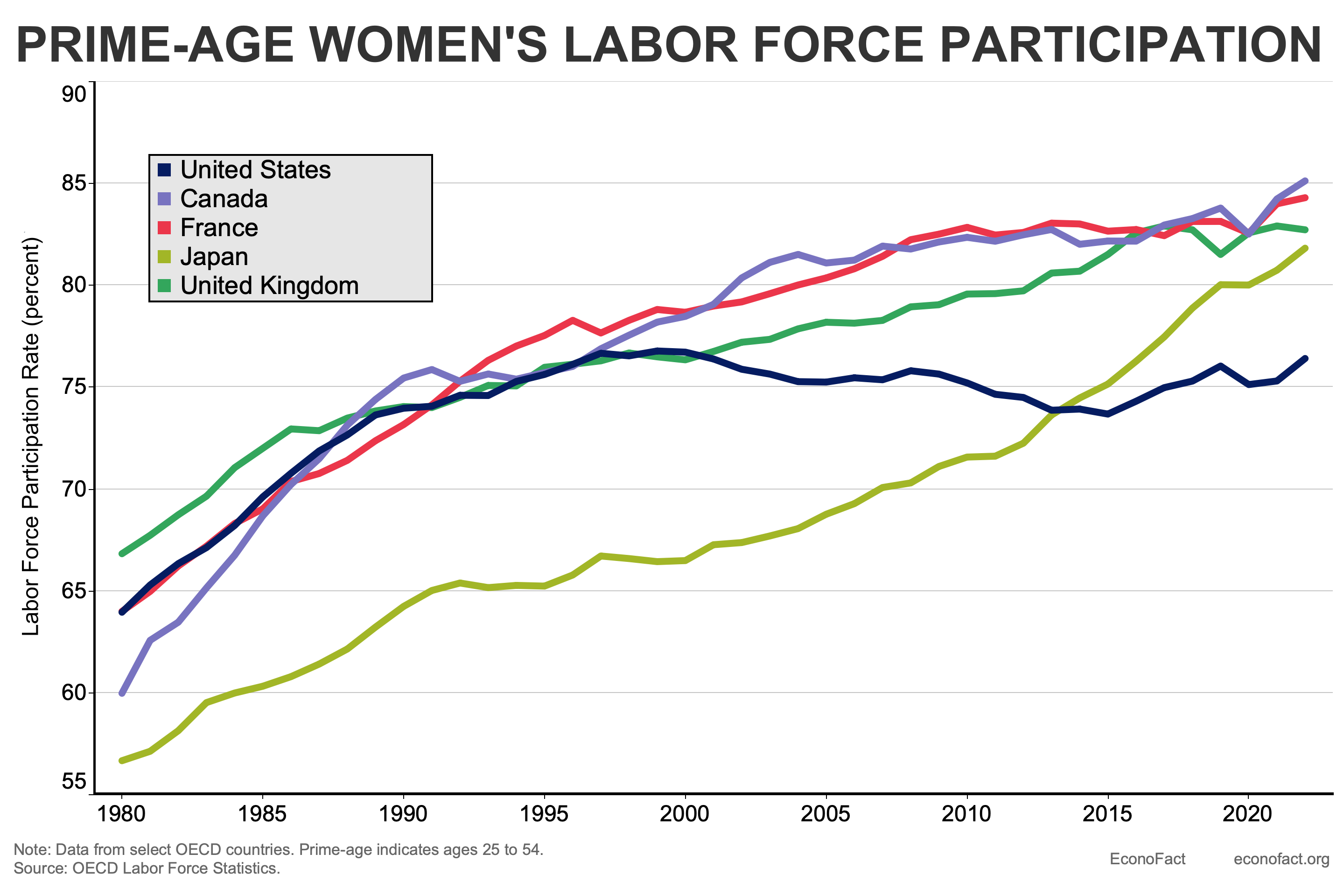Rising Strains in Childcare and Early Education | Econofact
Rising Strains in Childcare and Early Education Econofact


Labor Markets
EconoFact
The Issue:
The systems for providing childcare for infants and toddlers and pre-K education for young children are under strain in the United States. The cost of childcare severely stretches household budgets, especially for poorer families. Furthermore, in many areas commercial childcare options are very limited, or even nonexistent. There are economic arguments in favor of government support of child care since its benefits accrue to society at large and not just to the families using these services. But government support of childcare in the United States is low compared to many other OECD countries and the support that was provided as part of the COVID pandemic response expired last year. Why is childcare absent in many places, and so expensive where it is available? What are the economic and social consequences of the insufficient provision of childcare? What types of policies would make childcare and pre-K education more affordable, more accessible and more sustainable?
The failure of the childcare and early education business model has serious economic and social consequences.
The Facts:
- The high costs and limited availability of childcare and pre-K education present a substantial challenge for parents of young children in the United States. More than half of working parents face significant challenges to finding childcare that is affordable and high quality, according to a 2022 survey by Ready Nation. Child Care Aware estimates that the average annual cost of childcare for one child under six was $10,600 in 2021— more than a third of a single parent’s average income. Such costs have risen 220 percent since 1990, well in excess of the 140 percent rise in the general price level. And the cost relative to income is highest for low-income families, many of whom are minorities. The cost of care for two young children absorbed 26 percent of the average income of a white working mother, 42 percent of income for Hispanic mothers and 56 percent for Black mothers in 2017, according to a report cited in the 2023 Kids Count Data Book (see page 7).
- There are also areas where childcare is simply not available. A 2017 study that covered 22 states by the Center for American Progress found that more than half of the states’ residents lived in neighborhoods or communities either lacking any childcare options or with so few childcare providers that there were more than three children for every licensed childcare slot. These “childcare deserts” are disproportionately located in low-income urban and rural communities. Working families often have to resort to relying on friends and family. Difficulties in finding available childcare are also particularly acute for those engaged in irregular shift work or who work at night. In addition, an estimated 54 percent of young children do not have access to early childhood education, according to the Annie E. Casey Foundation’s 2023 Kids Count Data Book.
- The high costs and limited availability of childcare and early education reflect the dependence of these services on a relatively large number of workers per child. Labor costs account for 50 to 60 percent of licensed childcare providers’ costs according to the Center for American Progress. To qualify for government support, childcare centers need at least one qualified care provider for every three children (and must also meet minimum health and safety standards, although such standards are often not fully met). The nature of this work offers little scope for increases in labor productivity, which results in low profits for providers, typically less than one percent of revenues. Low productivity also results in low pay for workers; the median pay for credentialed childcare workers was $13.71 per hour in 2022, about half of the average pay for production and non-supervisory workers and 23 percent less than other workers with similar skills and training. One in seven childcare workers live below the poverty line (see here). Low pay and high stress result in high turnover. Childcare providers find it increasingly
SDGs, Targets, and Indicators
1. Which SDGs are addressed or connected to the issues highlighted in the article?
- SDG 1: No Poverty
- SDG 4: Quality Education
- SDG 5: Gender Equality
- SDG 8: Decent Work and Economic Growth
- SDG 10: Reduced Inequalities
- SDG 16: Peace, Justice, and Strong Institutions
2. What specific targets under those SDGs can be identified based on the article’s content?
- SDG 1.2: By 2030, reduce at least by half the proportion of men, women, and children of all ages living in poverty in all its dimensions according to national definitions.
- SDG 4.2: By 2030, ensure that all girls and boys have access to quality early childhood development, care, and pre-primary education so that they are ready for primary education.
- SDG 5.4: Recognize and value unpaid care and domestic work through the provision of public services, infrastructure, and social protection policies and the promotion of shared responsibility within the household and the family as nationally appropriate.
- SDG 8.5: By 2030, achieve full and productive employment and decent work for all women and men, including for young people and persons with disabilities, and equal pay for work of equal value.
- SDG 10.2: By 2030, empower and promote the social, economic, and political inclusion of all, irrespective of age, sex, disability, race, ethnicity, origin, religion, or economic or other status.
- SDG 16.3: Promote the rule of law at the national and international levels and ensure equal access to justice for all.
3. Are there any indicators mentioned or implied in the article that can be used to measure progress towards the identified targets?
- Proportion of men, women, and children living in poverty
- Access to quality early childhood development, care, and pre-primary education
- Recognition and valuation of unpaid care and domestic work
- Full and productive employment and decent work for women and men
- Social, economic, and political inclusion of all
- Promotion of the rule of law and equal access to justice
SDGs, Targets, and Indicators
SDGs Targets Indicators SDG 1: No Poverty 1.2: By 2030, reduce at least by half the proportion of men, women, and children of all ages living in poverty in all its dimensions according to national definitions. Proportion of men, women, and children living in poverty SDG 4: Quality Education 4.2: By 2030, ensure that all girls and boys have access to quality early childhood development, care, and pre-primary education so that they are ready for primary education. Access to quality early childhood development, care, and pre-primary education SDG 5: Gender Equality 5.4: Recognize and value unpaid care and domestic work through the provision of public services, infrastructure, and social protection policies and the promotion of shared responsibility within the household and the family as nationally appropriate. Recognition and valuation of unpaid care and domestic work SDG 8: Decent Work and Economic Growth 8.5: By 2030, achieve full and productive employment and decent work for all women and men, including for young people and persons with disabilities, and equal pay for work of equal value. Full and productive employment and decent work for women and men SDG 10: Reduced Inequalities 10.2: By 2030, empower and promote the social, economic, and political inclusion of all, irrespective of age, sex, disability, race, ethnicity, origin, religion, or economic or other status. Social, economic, and political inclusion of all SDG 16: Peace, Justice, and Strong Institutions 16.3: Promote the rule of law at the national and international levels and ensure equal access to justice for all. Promotion of the rule of law and equal access to justice Behold! This splendid article springs forth from the wellspring of knowledge, shaped by a wondrous proprietary AI technology that delved into a vast ocean of data, illuminating the path towards the Sustainable Development Goals. Remember that all rights are reserved by SDG Investors LLC, empowering us to champion progress together.
Source: econofact.org

Join us, as fellow seekers of change, on a transformative journey at https://sdgtalks.ai/welcome, where you can become a member and actively contribute to shaping a brighter future.








